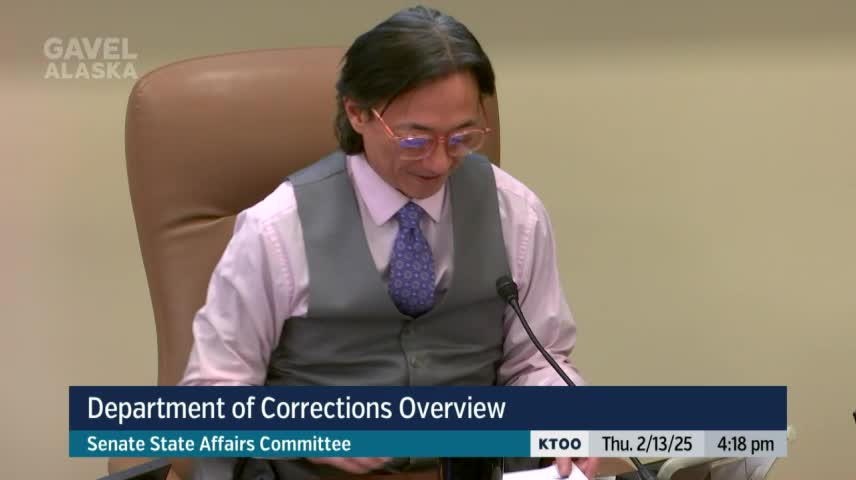DOC health and rehab director: corrections is Alaska’s largest behavioral‑health provider; 313 inpatient psychiatric beds systemwide
February 14, 2025 | 2025 Legislature Alaska, Alaska
This article was created by AI summarizing key points discussed. AI makes mistakes, so for full details and context, please refer to the video of the full meeting. Please report any errors so we can fix them. Report an error »

Travis Welch, director of Health and Rehabilitation Services (HARS) for the Alaska Department of Corrections, told the Senate State Affairs Committee on Feb. 13 that corrections remains one of the state’s largest behavioral‑health care providers and operates inpatient and subacute psychiatric units and programs for substance use disorder.
Why it matters: DOC health and rehabilitative services affect inmate care, hospital use, continuity of treatment after release, and state health spending.
Welch said DOC operates two acute inpatient psychiatric units (one at the Anchorage Correctional Complex and one at Highland Mountain for women) and five subacute units. In total the department reported about 313 inpatient psychiatric beds across facilities; the Alaska Psychiatric Institute (API) has roughly 80 inpatient psychiatric beds, 10 of which are forensic beds, Welch said.
The division reported about 1,200 individuals receive some level of substance‑use‑disorder services in DOC facilities, ranging from residential substance abuse treatment (RSAT) to outpatient models, and about 280 slots for structured substance‑use treatment programming. HARS described partnerships with community treatment providers — Set Free, True North Recovery, Salvation Army and Alaska Addiction Rehabilitation Services (AARS) — for bed‑to‑bed transfers into community programs and for pilot community placements.
Welch described an API‑DOC jail‑based restoration program: API clinicians come into the Anchorage Correctional Complex’s subacute psychiatric unit (Lima Mod) and provide outpatient restoration services to people in DOC custody who require competency restoration under Title 12 procedures. Welch said a similar model operates for women at Highland Mountain.
The division also described reentry services aimed at continuity of care after release, including medical social workers, an APIC (Assess, Plan, Identify, Coordinate) release program and a parallel IDP Plus casework approach for people on probation. REVS (Reentry Education and Vocational Services) coordinates education, vocational and reentry coalitions to link people to services and job training before release. Welch said a pilot pre‑apprenticeship with the Carpenters Union runs at Wildwood and Highland Mountain.
“We currently operate 2 acute inpatient psychiatric bed units… and we have about 313 inpatient psychiatric beds,” Welch told the committee, placing DOC treatment capacity in context with API.
Ending: Senators asked about release planning and continuity of care; HARS officials said case workers and reentry units coordinate with community partners to secure housing, Medicaid and other services prior to release. No formal committee action occurred.
Why it matters: DOC health and rehabilitative services affect inmate care, hospital use, continuity of treatment after release, and state health spending.
Welch said DOC operates two acute inpatient psychiatric units (one at the Anchorage Correctional Complex and one at Highland Mountain for women) and five subacute units. In total the department reported about 313 inpatient psychiatric beds across facilities; the Alaska Psychiatric Institute (API) has roughly 80 inpatient psychiatric beds, 10 of which are forensic beds, Welch said.
The division reported about 1,200 individuals receive some level of substance‑use‑disorder services in DOC facilities, ranging from residential substance abuse treatment (RSAT) to outpatient models, and about 280 slots for structured substance‑use treatment programming. HARS described partnerships with community treatment providers — Set Free, True North Recovery, Salvation Army and Alaska Addiction Rehabilitation Services (AARS) — for bed‑to‑bed transfers into community programs and for pilot community placements.
Welch described an API‑DOC jail‑based restoration program: API clinicians come into the Anchorage Correctional Complex’s subacute psychiatric unit (Lima Mod) and provide outpatient restoration services to people in DOC custody who require competency restoration under Title 12 procedures. Welch said a similar model operates for women at Highland Mountain.
The division also described reentry services aimed at continuity of care after release, including medical social workers, an APIC (Assess, Plan, Identify, Coordinate) release program and a parallel IDP Plus casework approach for people on probation. REVS (Reentry Education and Vocational Services) coordinates education, vocational and reentry coalitions to link people to services and job training before release. Welch said a pilot pre‑apprenticeship with the Carpenters Union runs at Wildwood and Highland Mountain.
“We currently operate 2 acute inpatient psychiatric bed units… and we have about 313 inpatient psychiatric beds,” Welch told the committee, placing DOC treatment capacity in context with API.
Ending: Senators asked about release planning and continuity of care; HARS officials said case workers and reentry units coordinate with community partners to secure housing, Medicaid and other services prior to release. No formal committee action occurred.
View full meeting
This article is based on a recent meeting—watch the full video and explore the complete transcript for deeper insights into the discussion.
View full meeting
